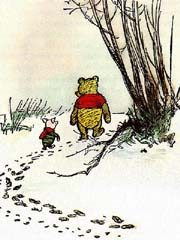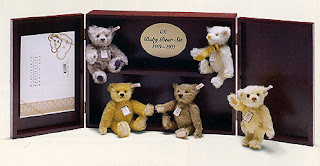
Wherever I am, there's always Pooh,
There's always Pooh and Me.
Whatever I do, he wants to do,
"Where are you going today?" says Pooh:
"Well that's very odd 'cos I was too.
Let's go together, " says Pooh.
(from Now We Are Six)
Winnie the Pooh is now over 70 years old, but his popularity continues to grow and he is without doubt 'the' most famous and best loved British Bear.
Pooh's creator Allen Alexandra Milne was born on 18th January 1882 in Hampstead, London, England. He was the youngest of three sons born to John Vine Milne and Sarah Maria Heginbotham.
A.A.Milne was able to read and write before the age of five, which is perhaps not surprising as his father was master of Heneley House, a private school for boys. However in 1893 at the age of eleven, he won a scholarship to Westminster Prep and from there in 1900 went on to Trinity College Cambridge. He graduated from Cambridge in 1903 with a degree in mathematics.
After graduation A.A.Milne moved to London and started work as a freelance writer. By1905 he was making regular contributions to Punch and his first book 'Lovers in London' was also published that year. In 1906 Milne became assistant editor of the Punch magazine and contributed a weekly 'essay'.
In 1913 he married Dorothy de Selincourt, (Daphne to friends) the God-daughter of Punch editor Owen Seaman. On the out break of the first world war, despite being a pacifist Milne joined the army on 10th February 1915 as a signalling officer. He was sent to France in the Spring of 1916 but he left the front lines Nov 8th 1916 suffering from trench fever. After his recovery he was put in charge of a signalling company at Fort Southwick until his discharge from the army on 14 February 1919. Later in his biography Milne described his war service as 'four years of mental and moral degradation".
After leaving the army A.A.Milne resigned his post at Punch and concentrated on writing plays. In 1923 his first children's poem "Vespers" was published in Vanity Fair. The poem featured his only son Christopher Robin. The poem had been written by Milne for his wife, Dorothy submitted Vespers to Punch magazine for publication without A.A.'s knowledge or permission. Dorothy also originally provided "voices" and personalities for many of the characters.
After the success of "Vespers" in 1924 Milne' published a book of children's poems entitled, When We Were Very Young. The book was illustrated by Punch illustrator E.H.Shepard who went on to illustrate all of Milnes children's books. When We Were Very Young proved to be an instant success and sold over 50.000 copies within eight weeks of being published.
When We Were Very Young included a poem about a Teddy Bear who "however hard he tries grows tubby without exercise". This was Pooh's first unofficial, appearance in A.A.Milne's writing. It was not until 1925 when Milne was asked to write something for the Christmas Eve issue of the Evening News, that Pooh officially came into being. Milne's contribution was a bedtime story that he had made up for his son about adventures he had with his Teddy Bear who was known as Winnie the Pooh origin of Pooh's name. It was also at this time that the Milne family moved to a cottage at Cotchford farm in Sussex which later provided the setting for the Pooh books.Photographs of the Area
The bedtime story formed the first chapter of Milnes next book entitled "Winnie the Pooh". This book featured short stories about Christopher Robin and his nursery toys and once again proved to be an instant success. This book was followed by Now We Are Six in 1927 and The House at Pooh Corner in 1928. In an attempt to shield his son from the publicity generated by the success of the Pooh stories Milne announced that The House at Pooh Corner would be his last Christopher Robin book.
Although Milne went on to write other plays and novels the Pooh stories remain his best known work.
The success of the Pooh books had however taken its toll on the Milne family. As Christopher grew older he resented being connected with the books and eventually virtually severed all connections with his family. For many years A.A.Milne himself resented the fact that his lterary fame was based on children's books, not on his other work. Though he himself insisted that he wrote the Pooh books "for grownups, and more particularly for two grownups. My wife and myself". (1)
Milne suffered a stroke in October 1952 and was left an invalid until his death on 31 January 1956. Christopher rarely visited his father during his illness and the memorial service held on 10 February was the last time he saw his Mother, despite the fact that she did not die until 1971.
Bibliography
(1)Swann, T. (1971) 'Why do so many grownups like WTP so much?' A.A.Milme, Boston:Twayne publishers Inc. p.66.
Milne,C. (1974) The Enchanted Places. Methuen.
J,Bingham (Ed). (1988) Writers for Children. Charles Scribrets Sons.
H,Carpenter & M, Pritchard (1984) The Oxford Companion to Childrens Literature. O.U.P






